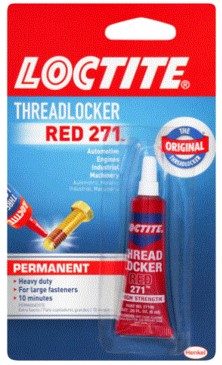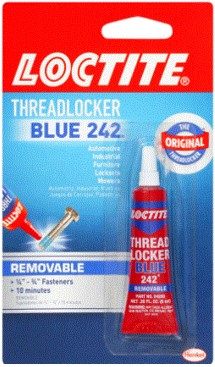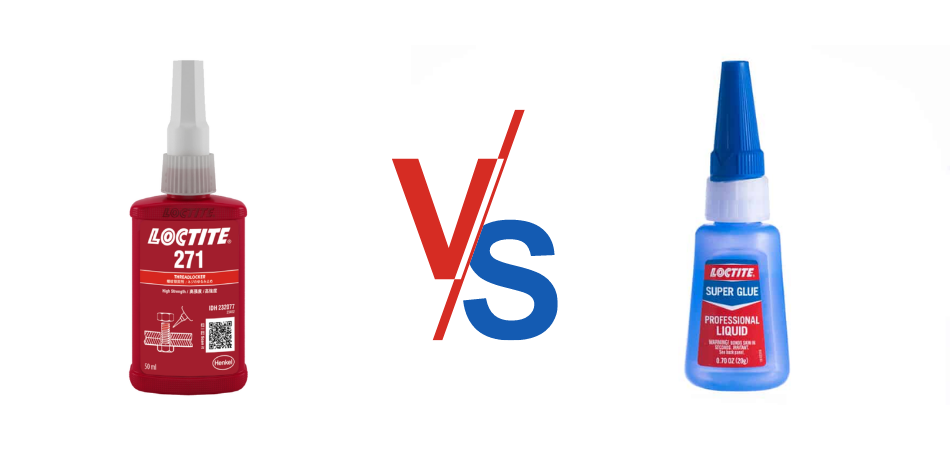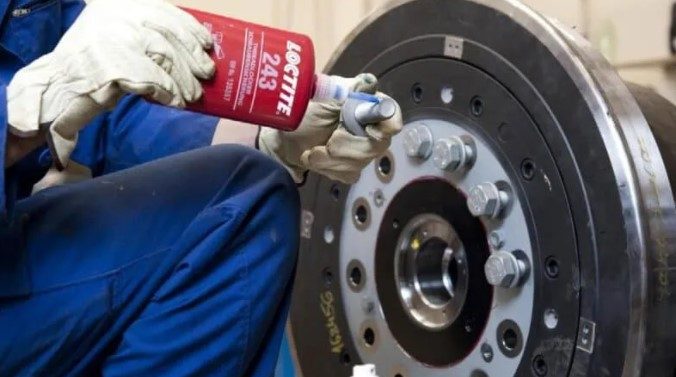Locking fasteners is very important in engineering. This is because most of these machines for intense work can shake the fasteners off sometimes. This can even cause an accident in the workshop. But when there is a fastener seal, such as the Loctite Red and Blue, the fasteners won’t fall off. Therefore, you can avert accidents from machine dissembling.
Other fields still need fastener seals, too, and the Loctite Thread locker Blue and Red is just the thing they need. Although the Loctite Red and Blue are both thread lockers, one does more work than the other.
If anyone is to compare Loctite Red vs. Blue, Red is stronger in its grip than Blue. However, you can replace the Loctite Blue easily with common tools, while the Red is harder to replace.
This article has everything on Loctite Red vs. Blue. It has its uses, PROs and CONs, a comparison chart, and the difference. Continue reading to learn more so that you can make the right color choice when you need a Loctite Thread locker for any job.
Loctite Red Vs. Blue: Comparison Chart
| Type | Color Code | Rotating force to break free
(3/8-16 size bolt) |
Rotation force to continue turning |
| Medium strength | Blue | 115 in-lb (12 N.m) | 53 in-lb (6 N.m) |
| Medium strength surface insensitive | Blue | 180 in-lb (20 N.m) | 62 in-lb (7 N.m) |
| High temperature | Red | 180 in-lb (20 N.m) | 270 in-lb (30 N.m) |
| High strength | Red | 230 in-lb (25 N.m) | 225 in-lb (25 N.m) |
What Is A Loctite Red?
In plain terms, Loctite Red is a product created to resist moisture in threads and seal leakage. The sealant protects threads from rusting, and it works fast that you can use it urgently. This Thread locker sets in 10 minutes and cures fully in 24 hours.

Loctite Red permanently seals and locks fasteners to prevent it from loosening from vibration. However, you can remove it with a heat level of up to 260ºC (500ºF). It is the strongest thread locker you can find in the market.
Loctite Red works best for fasteners that are about 25mm. This makes them best for machines, engines, and vehicles like motorcycle. It is also best for water pumps, alternators, and valve covers. And the best part is, Loctite Red works with all metals, and it now has oil tolerance.
Pros And Cons Of Loctite Red
The pros of Loctite Red are as follows-
-
Permanent lock:
Loctite Red is a permanent thread locker for long-term locking and sealing of fasteners. You cannot remove the Loctite Red with a common tool. This makes it secure for people who do not intend to remove the threaded fastener in a short while.
-
Speed:
The thread locker works fast. If you need urgent fixing and sealing of your vehicle or engine fastener, Loctite Red is the product for you. It settles for 10 minutes and cures completely in 24 hours, and that is pretty fast for thread lockers.
-
Minimal application:
You do not need to apply the thread locker excessively for it to work. Just a little application on your fastener properly can do the job.
-
Easy to use:
The most interesting part of the Loctite Red is that it is easy to use. Applying it on your fastener doesn’t need a guide manual. Just apply a negligible quantity on the tip of the faster and let it drip around the thread, then screw it back in.
-
Visibility:
The thread locker has a dark color, so it is easy for you to see the parts of the thread where the locker has covered.
The cons of Loctite Red are as follows-
-
Permanent lock:
In the same way, a permanent lock of the thread locker is an advantage; it is also a disadvantage. It is not all the fasteners that need to be locked permanently. Some components of a machine need accessibility from time to time. So, with this in mind, sealing the thread permanently is a bad idea.
-
Light liquid:
The Loctite red liquid is too light. It might give people who are new to the product a tough time to use it. This is because when you apply drops at the tip of the threaded-faster, it might run down fast and drip off the fastener. It can get uncontrollable and annoying in such cases.
What Is A Loctite Blue?
Like the Loctite Red, the Loctite Blue is created to seal and lock fasteners with threads. It keeps the fasteners from falling off during vibrations to cause a disassembling amongst machine parts. But unlike the Loctite Red, the Loctite Blue is best for fasteners that are about 6 to 19mm long.

This quality makes the Loctite Blue ideal for mowers, power equipment, small motors, and other machines that are similar to this list.
The thread locker keeps the faster from leaking, corrosion, and rusting. With Loctite Blue, you do not need to spend extra cash to get expensive washers and nuts.
The Loctite Blue is easy to replace. It works best for stainless steel and surfaces that are plated. Use it for components that require servicing or changing from time to time.
Pros And Cons Of Loctite Blue
The Pros of the Loctite Blue are as follows-
-
Easily replaceable:
That the Loctite Blue is easily replaceable is an advantage for when you apply it on the part of a machine that you visit often. This way, you can easily take it off, service the components and apply another thread lock to lock the component’s fastener again.
-
Works even on oil:
No need to worry about cleaning off the oil on the fastener before applying the Loctite Blue. This thread locker works over the oil on the fastener and still does its job effectively.
-
Easy to use:
Even people who are new to this substance can use it because of how user friendly it is. It takes just applying the substance to the tip of your fastener and allowing it to cover other parts slowly. After doing that, put the fastener back on the machine and tighten it.
-
Thick substance:
The Loctite Blue substance is thick, and this is an advantage because it won’t run out of control on the fastener. You can monitor it to slowly cover the areas you want it to cover or even use your thumb to direct it properly. The thick nature of the substance makes it easier to use.
The Cons of the Loctite Blue are as follows-
-
Easily replaceable:
That the Loctite Blue is easily replaceable is also a disadvantage in some aspects of engineering. If you apply this substance to a part of a machine that doesn’t need frequent checking, it will be detrimental to the machine.
Since it is easily replaceable, the substance might get to its heat limit and get weakened. Then the fastener will fall off, and the component of that machine will dissemble.
Loctite Red Vs. Blue: What Are The Differences?
Loctite Red vs. Blue will give a comprehensive and distinctive result even if they both work for the same thing. Since they have almost the same features, we will take you through their feature with notable differences.

The Difference in Bond Strength:
Loctite Red has more bonding strength than Loctite Blue. For Loctite Red, it will take a high level of heat to break the seal, and for Loctite Blue, it will take lesser. They both have their advantages, but this difference is glaring. This means Loctite Red is harder to remove than Loctite Blue.
Difference in Uses:
The bond strength difference also makes way for the usage difference. Since the Loctite Red has a stronger bond strength, you can use it for engineering component fasteners that don’t need regular monitoring. While the Loctite Blue is for the fasteners you need to service or check on from time to time.
The Difference in Substance Texture:
Loctite Red has a light substance that runs when you just apply a little drop on a surface. But, Loctite Blue’s substance is thicker than the Red. Most times, the thickness difference is not heavy, but it is there.
Application Difference:
For Loctite Blue, you do not need to get rid of the oil or grease on the fastener for it to work. But for Loctite Red, you need to clean the oil off, as it might obstruct the efficiency of the thread locker.
Should I Use Red Or Blue Loctite?
The decision to use red or blue Loctite is not completely yours to make. But it rather depends on the component whose fastener you want to seal to make. It is also of the length of the faster to make.
So, if the component does not require regular servicing or checkups, we recommend the red Loctite for the fasteners. This is because the blue Loctite is easier to remove, and you don’t want it to wear off with time and the fastener to fall off the machine. So, it is easier to just use the red Loctite for a long-term seal and lock.

Then, if the component requires regular servicing and monitoring, we recommend the blue Loctite for sealing its fasteners. This is because the red Loctite is hard to remove, and you don’t want to go through the stress of removing it regularly to service the part. So, the easy means is just to use the blue Loctite, as it is workable for short-term usage.
Also, if the fastener you want to seal and lock with the thread locker is about 6 to 19mm long, the blue Loctite is good for it. A report on the features of the blue Loctite shows that the Loctite is ideal for fasteners that are up to 6mm to 19mm long.
A report on the red Loctite shows that the Loctite is best for 25mm fasteners. Then, we advise you to use the red Loctite for fasteners that are up to 25mm long. They mostly used these long fasteners on important and big components of a machine. Such components do not need regular servicing to keep them running.
Final Verdict
Red and blue Loctite work for one purpose: sealing and locking fasteners to avoid leaks. Also, they prevent the fasteners from rusting and corrosion. However alike they might be, if you scrutinize the Loctite Red vs. Blue, you will note the difference between them.
The red Loctite has more grip on the fasteners than the blue. The blue Loctite has a thicker substance than the red and many more differences. It is essential to know that both the red and blue Loctite are ideal for threaded fasteners.
